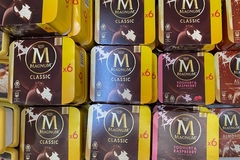
- Industry news
Industry news
- Category news
Category news
- Reports
- Key trends
- Multimedia
- Journal
- Events
- Suppliers
- Home
- Industry news
Industry news
- Category news
Category news
- Reports
- Key trends
- Multimedia
- Events
- Suppliers
Migros and SuperMeat to scale supermarket aisles with cell-based “meat, fat and everything in between”

28 Jul 2022 --- Israeli food-tech start-up SuperMeat has inked an agreement with Switzerland’s largest supermarket and meat manufacturer, Migros, to develop European infrastructure to produce, distribute and sell cell-based meat on a broad commercial scale.
FoodIngredientsFirst speaks to SuperMeat CEO, Ido Savir, about the commercial pathways gradually opening up, while commenting on the potential for pushback from industry’s conventional animal protein players.
“The partnership could lead to Migros’ own branded cultivated meat products,” highlights Savir. “As a B2B company, SuperMeat plans to enable other food companies to introduce their own meat products with SuperMeat's cultivated meat inside. The possibilities for products that could come from this partnership are endless,” he says.

“SuperMeat is building a wide platform for meat production – from fat to thigh and anything in between – aiming to provide Migros and other leading brands the diverse tool box to produce the high quality products their consumers expect.”
“Our first commercial products will be cultivated chicken products, followed closely by multiple other types of meat types and parts,” he details.
First movers in a new F&B arena
SuperMeat positions itself as the first B2B company to address the entire category of poultry meat from fat to muscle, offering a “complete solution” to cultivated meat production. The food-tech specialist has previously piloted cell-based chicken in cutlet, skewer and burger formats.
 Cell-based chicken cutlet by SuperMeat (Credit: SuperMeat).The company has been showcasing the versatility of its meat platform in various events at its pilot production plant, The Chicken, the world’s first farm-to-fork facility for local meat production. It also previously worked with food industry giants by the likes of Japanese food and biotech giant Ajinomoto.
Cell-based chicken cutlet by SuperMeat (Credit: SuperMeat).The company has been showcasing the versatility of its meat platform in various events at its pilot production plant, The Chicken, the world’s first farm-to-fork facility for local meat production. It also previously worked with food industry giants by the likes of Japanese food and biotech giant Ajinomoto.
“Migros’ extensive infrastructure, such as processing facilities, distribution centers and storage facilities, as well as many points of sales both in Switzerland and in neighboring countries, can support scale up and cost reduction efforts,” says Savir.
In addition to its collaboration with SuperMeat, Migros previously partnered with Swiss companies Givaudan and Bühler to establish The Cultured Food Innovation Hub – located in The Valley in Kemptthal, a “hotbed of innovation and technology” just outside of Zurich – with the goal of constructing a pilot plant to further study and grow cultivated meat.
With the technology behind cell-based meat becoming increasingly sophisticated, analysis by Dutch research organization CE Delft finds that cultivated meat may hit competitive cost and environmental benchmarks by 2030.
Gauging the market
In the EU, once cultivated meat products are approved, they can be sold in all 27 member states. “According to our estimates, such approvals will take two to three years, and we’ll see similar timeframes for non-EU members like the UK and Switzerland,” affirms Savir.
He notes there are, however, a few European markets that provide more favorable conditions and support, including the Netherlands, which recently approved a resolution to allow taste tests of cultured meat under controlled conditions.
The same is said about the UK, which is “accelerating its approval process and has a supportive environment,” according to Savir. Germany also holds similar potential, where leading local companies like SuperMeat’s partner PHW – Germany’s largest meat company – and Merck are active in the field.
 Cultivated chicken burger by SuperMeat (Credit: SuperMeat).“Furthermore, a PHW survey revealed more than half of German consumers have already expressed interest in trying cultivated meat,” notes Savir.
Cultivated chicken burger by SuperMeat (Credit: SuperMeat).“Furthermore, a PHW survey revealed more than half of German consumers have already expressed interest in trying cultivated meat,” notes Savir.
“It has been shown in various studies that Europeans are open to trying cultivated meat products and that even today, when cultivated meat is not yet commercialized, consumers who are hesitant to try it are a minority. Swiss consumers are no different.”
“Consumer acceptance and perception are likely to improve as cultivated meat companies demonstrate that they can meet the highest standards of quality control and food safety,” he underscores.
The future of meat
Industry’s conviction about the marketability of cell-based meat has led to significant firsts for the secretary, including “ocean-free” cultured oysters, shrimp and even cultivated antelope from South Africa.
The space has already expanded into the premium category with the launch of cell-based marbled Wagyu ribeye beef.
As the movement gains traction, food companies, regulators, marketers, journalists and others have been highly encouraged to stick to the terms “cell-based” or “cell-cultured” when labeling or talking about cultivated meat products, according to a recent Rutgers study in the Journal of Food Science.
“In terms of labeling, it has not yet been decided how cultivated meat products will be labeled in Switzerland,” notes Savir. “However, we will comply with Swiss law for labeling meat and meat products, and make the necessary accommodations to satisfy the Swiss government regarding nomenclature, explanations and claims.”
 Cultured chicken skewers by SuperMeat (Credit: SuperMeat).Helping, not hurting traditional agriculture
Cultured chicken skewers by SuperMeat (Credit: SuperMeat).Helping, not hurting traditional agriculture
The genesis of the cell-based protein renaissance is met with the question of what will be left of conventional agriculture in the coming decades once the movement fully takes off.
A host of cell-based pioneers speaking to FoodIngredientsFirst previously underscored that cultured meat companies have a significant opportunity to collaborate with farmers at early stages of production, involving them in cell sourcing and cell feedstock – rather than compete with them.
Savir responds: “It is inevitable that there will be opponents to the introduction of new technology and developments, but many of the leading meat players who are vertically integrated have already invested in the field and are actively supporting the development of the cultivated meat industry.”
“When we consider the incorporation of traditional meat workers into the cultivated meat industry, we need to remember that many parts of the production process of cultivated meat will be the same as the production process of traditional meat, and the same jobs and workforce will be necessary.”
In order to grow the cultivated meat industry, traditional meat workers will be needed, he adds.
“Workforce integration will primarily involve downstream activities, including wholesale and processing, plant managers, food safety experts, food technologists, as well as packing, labeling, storing, and distributing cultivated meat.”
“In those production parts that are different, since this industry will eventually become part of the overall meat industry, people will be trained from the beginning and/or transition easily,” he concludes.
Exploring a different debate, FoodIngredientsFirst previously caught up with SuperMeat and cell-based firm Aleph Farms, alongside experts from the UK’s United Synagogue and the Islamic Chamber of Halal Certification Services, to explore how modern meat cultivation can be reconciled with long-held religious traditions.
By Benjamin Ferrer










